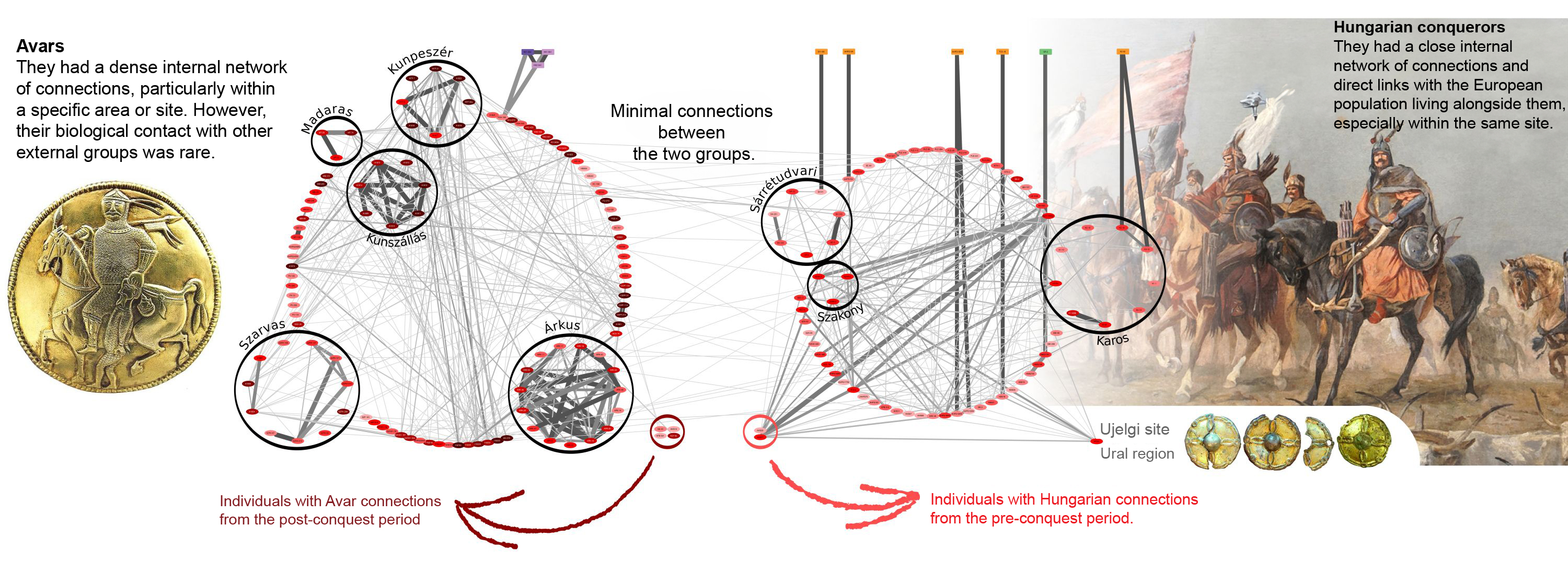The Most Comprehensive Genetic Study of the Migration Period in the Carpathian Basin Published
A new study led by the Institute of Archaeogenomics at the HUN-REN Research Centre for the Humanities (HUN-REN RCH) has been published in Science Advances, presenting the most comprehensive genetic research to date on the Migration Period in the Carpathian Basin. The interdisciplinary project also involved the HUN-REN RCH Institute of Archaeology, the HUN-REN Research Centre for Astronomy and Earth Sciences, the Wigner Datacentre, and several other Hungarian institutions.
Under the leadership of the Institute of Archaeogenomics at the HUN-REN Research Centre for the Humanities, the most comprehensive archaeogenomic study of the Migration Period in the Carpathian Basin has been conducted. The researchers utilised the HUN-REN CLOUD services to meet the significant computational demands of identity-by-descent (IBD) analyses. These analyses enabled the identification of kinship relationships up to the tenth degree among ancient remains. Researchers at the Institute of Archaeogenomics were among the first to apply this method to the genetic analysis of ancient remains, offering unprecedented insight into the population processes of the era.
The research began in 2018 as part of the Árpád Dynasty Programme, supported by the Ministry of Human Resources. Its aim was to investigate the genetics of 8th–11th century populations in Transdanubia and compare them with previously analysed genomes of a similar age from Hungary. By expanding the scope of sampling both geographically and chronologically, the researchers ultimately collected 296 human remains from 7th–11th century cemeteries in Transdanubia. The dataset was further enhanced with a sample from a site beyond the Ural Mountains, linked to the early Hungarians. The analyses primarily focused on cemeteries and burials from the transitional period between the final decades of the Avar Khaganate, which lasted from AD 568–811, and the establishment of the Hungarian state. While previous archaeogenetic studies have identified the Inner Asian origins of the elite ruling class of the Avars, who dominated the Carpathian Basin for 250 years, new research questions have emerged. These include the relationships between the Avars and local populations, the connections between the Avars and the conquering Hungarians, and the survival of their descendants in the 9th and 10th centuries.
The results are extremely complex and multifaceted:
1. The baseline population of the Carpathian Basin during the Migration Period has been described. The authors of the study genetically identified this population, tracing its roots back to the European Bronze Age. This population in the Carpathian Basin encountered the Avars from the east and later the conquering Hungarians, interacting with them in various ways. The population consisted of several communities and groups and underwent diverse genetic influences and internal transformations over the centuries of the Migration Period.

Genetic composition of the baseline population of the Carpathian Basin during the Migration Period. A principal component analysis (PCA), with the genomes of modern West Eurasian individuals represented by grey circles, based on the analysis of several hundred thousand genomic markers. This figure shows the composition of the Migration Period population in the Carpathian Basin during the 5th-11th centuries, using coloured markers and grey crosses. The European baseline population (represented by coloured markers) is predominantly distributed along a north-south genetic axis. Individuals marked with grey crosses generally exhibit some non-European (mainly Asian and Middle Eastern) genetic components, consistent with their distance from the aforementioned axis. Populations entering the Carpathian Basin, regardless of their origin, never reached a critical population size that would have significantly shifted this predominantly European genetic make-up, which largely persists today. The pie charts clearly demonstrate that the proportions of different European genetic groups, marked by colours, changed considerably over the centuries, indicating that the Carpathian Basin did not have a static baseline population during the period studied.
2. The relationships between the Huns, Avars, early Hungarians, and the baseline populations of the Carpathian Basin have been clarified. The IBD method enabled the researchers to map the network of relationships among these ancient peoples. It revealed that the biological continuity of the genetically East Eurasian groups in the Carpathian Basin during the Hun period could no longer be traced in the time of the Hungarian conquest. The individuals identified as Avars, who were also genetically of East Eurasian origin, made up about one-fifth of the Carpathian Basin’s population at the time. They formed a highly isolated group and rarely intermarried with the local populations. Similar to the East Asian-origin population of the Hun period, the biological continuity of the East Eurasian Avars after the Hungarian conquest was sparse, genetically ruling out theories of a shared origin or continuity. In contrast, although the genetic group associated with the early Hungarians constituted only one-tenth of the European baseline population that survived the Avar period in the region, signs of genetic mixing with them were evident from the moment of their arrival. These results not only shed light on the social structural differences between the Avars and Hungarians but may also provide an explanation as to why the Hungarians survived both genetically and culturally in subsequent periods.
3. The researchers examined the transformations in the population of the Carpathian Basin between the 6th and 11th centuries. The analysis of genetic networks revealed the altered marriage and connection structures of the Avars in the 7th century, the separation of Transdanubia and the Great Hungarian Plain before the Hungarian conquest, the mass arrival of the conquering Hungarians in the early 10th century, and the subsequent population movement that resulted in a reorganisation of the entire population of the Carpathian Basin. The presence of the conquering Hungarians in the late 9th and early 10th centuries is primarily evident in the Great Plain, and their settlement in Transdanubia was later accompanied by part of the baseline population from the Great Plain in the second half of the 10th century. It was during this second phase that the small local groups observed in earlier periods—some of which had remained biologically intact or isolated since Celtic times—began to intermingle through partnerships.
4. It was revealed that individuals associated with the Hungarians were present in Transdanubia even before the conquest. Researchers identified an adult male from the AD 870–890 period of Mosaburg (modern-day Zalavár-Vársziget), a key power centre in the 9th–11th centuries, as an early conqueror of Hungarian origin from the Ural region. Genetic analysis also identified a fifth-degree familial relationship between this individual and a 10th-century male from the Great Hungarian Plain (Kenézlő-Fazekaszug site). This finding supports the theory that Hungarians may have appeared in western regions, including the power centre of Lower Pannonia, before the conquest, likely as members of an armed retinue.

The genetic network of populations entering the Carpathian Basin from the east during the Migration Period A subset of the analysis of shared genomic segments between individuals (IBD analysis). Individuals carrying eastern (Asian) genetic components are highlighted in red. These individuals form two distinct groups, differentiated by both chronological periods (6th-9th and 10th-11th centuries) and their genetic networks. The group on the left is identified as Avars, while the group on the right consists of Hungarian conquerors. Several individuals in the latter group show close genetic connections with an individual buried at the Ujelgi site, beyond the Ural Mountains. Although both groups exhibit dense internal genetic networks, their patterns of relationships differ. The Hungarian conquerors also had more direct genetic connections with the local baseline population, represented by the colours in the first figure (for simplicity, European individuals without eastern genetic components are not shown in this figure).
The publication, marking the conclusion of a six-year series of investigations, was authored by Dániel Gerber, Veronika Csáky, and Bea Szeifert as lead authors, under the supervision of Anna Szécsényi-Nagy and Béla Miklós Szőke. A detailed report on the research is available in Hungarian on the website of the Institute of Archaeogenomics.

